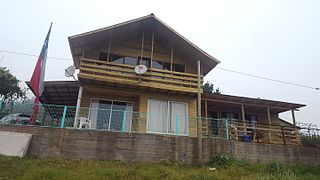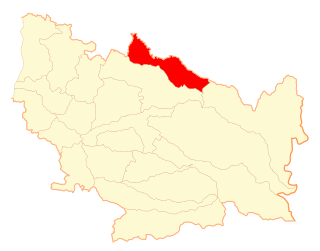
The Maule Region is one of Chile's 16 first order administrative divisions. Its capital is Talca. The region derives its name from the Maule River which, running westward from the Andes, bisects the region and spans a basin of about 20,600 km2. The Maule river is of considerable historic interest because, among other reasons, it marked the southern limits of the Inca Empire.

Linares is a Chilean city and commune located in the Maule Region and lies in the fertile Chilean Central Valley, 303 km (188 mi) south of Santiago and 50 km (31 mi) south of Talca, the regional capital. Linares is the capital city of the province of Linares.

The Diocese of Linares is a Latin Church ecclesiastical territory or diocese of the Catholic Church in Linares, Chile. It was established by Pope Pius XI on October 18, 1925 in his papal bull Notabiliter Aucto.

Cauquenes, a city and commune in Chile, is the capital of the Cauquenes Province and is located in the Maule Region.

San Javier is a Chilean city and commune located in the Province of Linares, Maule Region. The city lies in the geographical center of the country, some 270 km (168 mi) south of Santiago, 31 km (19 mi) to the northwest of the provincial capital, Linares, and 24 km (15 mi) to the south of Talca, the regional capital. The Pan-American Highway passes through the commune of San Javier, touching tangentially the eastern side of the town. A paved road connects San Javier with Colbún, Colbún dam lake and Panimávida and Quinamávida hot springs.

Linares is one of four provinces of the central Chilean region of Maule (VII). The provincial capital and most populous center is the city of Linares.

Villa Alegre a commune and city located in Linares Province, Maule Region of Chile. With 189.8 km2 (73 sq mi), Villa Alegre is the smallest commune by area in the Maule Region. It sits 92 m (302 ft) above sea level.

Pelluhue is a town and commune in the Cauquenes Province of central Chile's seventh region of Maule.

Chanco is a Chilean town and commune located in Cauquenes Province, Maule Region.
Colbún is a Chilean town and commune in Linares Province, Maule Region. The commune has a population of over 17,000 inhabitants and covers an area of 2,900 km2 (1,120 sq mi), making it the province's largest. Its capital, the town of Colbún, has 3,679 inhabitants. It is 7 km (4 mi) west of the center of continental Chile.

Yerbas Buenas is a Chilean town and commune in Linares Province, Maule Region. It lies in the geographical center of the country, on the fertile central plain, some 300 km (186 mi) south of the national capital of Santiago, 50 km (31 mi) south of Talca, the regional capital and 12 km (7 mi) north of Linares, the provincial capital.

Longaví is a Chilean city and commune located in Linares Province, one of the four provinces that make up the Maule Region, in the geographical center of Chile.
Retiro is a town and commune in Chile, located in Linares Province, in the seventh region of Maule.
Empedrado is a town and commune in the Talca Province of Chile's Maule Region.
Río Claro is a commune of the Talca Province in Chile's Maule Region. The municipal seat is the town of Cumpeo. The Claro River valley is an affluent community.
Pelarco is a town and commune in Talca Province, Maule Region of Chile. The commune spans an area of 331.5 km2 (128 sq mi).
Vichuquén is a commune in the Curicó Province of Chile's Maule Region.
Romeral is a Chilean town and commune in Curicó Province, Maule Region. The commune spans and area of 1,597.1 km2 (617 sq mi).
Maule is a town and commune in Talca Province in central Chile's Maule Region. It takes its name from the Mapudungun words for "valley" (mau) and "rainy" (len).

Ñiquén is a commune of the Punilla Province, located in the north of the Ñuble Region of Chile. Geographically, it is delimited by the Perquilauquén River to the north and the Ñiquén River in the south. Its boundary to the north is the commune of Parral and to the west that of Cauquenes both in the Maule Region, to the south with the commune of San Carlos, and to the east with San Fabian de Alico. The town of San Gregorio is the capital of this commune.

















